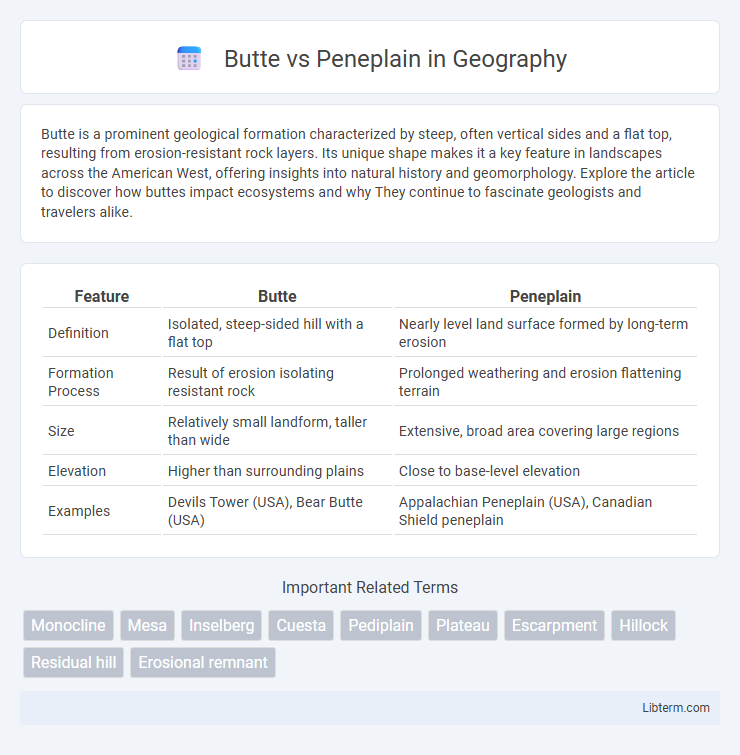Butte is a prominent geological formation characterized by steep, often vertical sides and a flat top, resulting from erosion-resistant rock layers. Its unique shape makes it a key feature in landscapes across the American West, offering insights into natural history and geomorphology. Explore the article to discover how buttes impact ecosystems and why They continue to fascinate geologists and travelers alike.
Table of Comparison
| Feature | Butte | Peneplain |
|---|---|---|
| Definition | Isolated, steep-sided hill with a flat top | Nearly level land surface formed by long-term erosion |
| Formation Process | Result of erosion isolating resistant rock | Prolonged weathering and erosion flattening terrain |
| Size | Relatively small landform, taller than wide | Extensive, broad area covering large regions |
| Elevation | Higher than surrounding plains | Close to base-level elevation |
| Examples | Devils Tower (USA), Bear Butte (USA) | Appalachian Peneplain (USA), Canadian Shield peneplain |
Introduction to Butte and Peneplain
A butte is an isolated hill with steep, often vertical sides and a small, flat top, formed predominantly through erosion in arid regions. A peneplain represents an extensive, nearly level land surface created by prolonged erosion and weathering, approaching a base level near sea level. Both landforms illustrate different stages and scales of landscape evolution shaped by geological processes over time.
Geological Definitions: Butte and Peneplain
A butte is a prominent isolated hill with steep, often vertical sides and a small, flat top, typically formed by erosion of surrounding softer rock layers. A peneplain represents an extensive, nearly level land surface produced by prolonged erosion and weathering, approaching a nearly flat plain. Geologically, buttes signify isolated erosional remnants, whereas peneplains indicate the advanced stage of landscape erosion approaching a base level.
Formation Processes of Buttes
Buttes form through differential erosion where hard, resistant rock layers cap softer sedimentary rock, protecting underlying material from rapid weathering while surrounding areas erode away. This process involves wind, water, and temperature fluctuations breaking down less durable rock, leaving isolated, steep-sided hills with flat tops. The unique geology and climate play critical roles in the butte's distinct shape compared to the more gently sloping, extensively leveled peneplain surfaces.
Formation Processes of Peneplains
Peneplains form through prolonged and extensive geomorphic processes involving long-term erosion and weathering that gradually lower a land surface to near sea level. Unlike buttes, which are isolated hills with steep sides formed by differential erosion resistant rock layers, peneplains develop from the planation of extensive areas as rivers and weathering wear down highlands over millions of years. The slow, uniform erosion during stable tectonic periods facilitates the development of a nearly flat and featureless surface characteristic of peneplains.
Key Differences: Butte vs Peneplain
A butte is an isolated hill with steep, often vertical sides and a small, flat top, typically formed through erosion processes in arid regions. In contrast, a peneplain is an extensive, nearly level land surface produced by prolonged erosion, representing the final stage of landscape evolution. The key difference lies in scale and formation: buttes are prominent, localized landforms, while peneplains are broad, subdued terrains formed over millions of years.
Physical Characteristics and Appearance
A butte is an isolated, steep-sided hill with a flat or rounded top, typically formed from erosion-resistant rock layers, standing prominently above the surrounding terrain. In contrast, a peneplain is an extensive, nearly level land surface resulting from prolonged erosion that reduces landscapes to a minimal relief over vast areas. Buttes are characterized by their striking vertical prominence and rugged appearance, while peneplains exhibit smooth, gently undulating topography with minimal elevation differences.
Notable Examples Around the World
Buttes appear prominently in Monument Valley, USA, with iconic formations like East and West Mitten Buttes, characterized by isolated, steep-sided hills. Peneplains are exemplified by the Canadian Shield, featuring extensive, gently undulating landscapes formed by long-term erosion and weathering processes. Both structures highlight distinct geological processes shaping Earth's surface over millions of years.
Importance in Geomorphology
Buttes and peneplains are crucial landforms in geomorphology that illustrate different stages of landscape evolution. Buttes represent isolated, steep-sided hills formed by erosion-resistant rock layers, indicating active erosional processes and geological history of uplift and weathering. Peneplains, on the other hand, signify extensive, nearly level surfaces formed by prolonged erosion, reflecting a mature landscape stage that aids in understanding long-term tectonic stability and denudation rates.
Ecological and Environmental Significance
Buttes, with their steep, isolated rock formations, serve as unique habitats supporting specialized flora and fauna adapted to harsh, exposed conditions, while also influencing local microclimates and erosion patterns. Peneplains represent extensive, nearly level land surfaces formed by long-term erosion, providing stable ecosystems that support diverse vegetation and soil development crucial for carbon sequestration and water retention. Both landforms play vital roles in ecological balance, habitat diversity, and landscape evolution, shaping biodiversity and environmental sustainability in their respective regions.
Summary: Choosing Between Butte and Peneplain
Buttes are isolated hills with steep, often vertical sides and a small, flat top, formed primarily by erosion, making them distinct landforms in arid regions. Peneplains are vast, nearly level land surfaces representing the final stage of erosion, indicating long-term geological stability and landscape leveling. Choosing between studying a butte or a peneplain depends on whether the focus is on localized erosion processes and topographic relief or on extensive, mature erosion surfaces reflecting long-term geological conditions.
Butte Infographic

 libterm.com
libterm.com